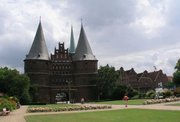|
|
Template:Luebeck infobox Lübeck (Template:Pronunc, population (2003): 214,338) is the second largest city in Schleswig-Holstein, in northern Germany. It was for several centuries the "capital" of the Hanseatic League and because of its architectural heritage is on UNESCO's list of World Heritage Sites.
Lübeck is situated at the Trave river with the largest German port at the Baltic Sea. The old part of the town is an island enclosed by the Trave and the Elbe-Lübeck Canal. The borough Travemünde is a sea ressort and ferry port at the coast of the Baltic Sea.
| Contents [hide] |
Buildings
The old town is dominated by seven church steeples. The eldest ones are the Dom and the Marienkirche (Saint Mary), both from the 13th and 14th centuries. Once the town could only be entered by passing one of four town gates, of which the Holstentor (1478) is the best known. The entire old town has kept a medieval look with old buildings and narrow streets.
History
Originally recorded in Germania, the area around Lübeck was by the year 1000 AD inhabited by Slavic peoples, who settled at the Trave banks some kilometers outside the today town centre. They were subdued in 1158 by Henry the Lion, who newly founded the city. In the 14th century Lübeck became the "Queen of the Hanseatic League", being by far the largest and most powerful member of this medieval trade organization. In 1533 an armed conflict with Denmark led to the loss of the power.
Miscellaneous
Two nobel laureates, the German writer Thomas Mann and former German chancellor Willy Brandt were born in Lübeck.
Lübeck is very famous for its excellent marzipan industry, and Marzipan was believed to have been invented in Lübeck possibly in response to either a military siege of the city, or a famine year. The story, perhaps apocryphal, is that the town ran out of all foods except stored almonds and sugar and made loaves of marzipan "bread" with it.
Others believe that marzipan was actually invented in Persia a few hundred years before Lübeck claims to have invented it.
In the quarter Lübeck-Herrenwyk there is the static invertor station of the HVDC Baltic-Cable.
Parts
Lubeck-townhall-detail.JPG
View_of_Lubeck_and_its_Harbour_Sixteenth_Century_From_a_Copper_plate_in_the_Work_of_P_Bertius_Commentaria_Rerum_Germanicarum_in_4to_Amsterdam_1616.png
The city of Lübeck is divided into 10 quarters. These again are arranged into altogether 35 urban districts. The 10 quarters with their official numbers, their associated urban districts, their official numbers as well as any numbers of inhabitants of the quarters:
- 01 City center (~ 12.000 Inhabitants)
- 02 St. Jürgen (~ 40.000 Inhabitants)
- 02 Huextertor / Muehlentor / Gaertnergasse
- 09 Strecknitz / Rothebek
- 10 Blankensee
- 11 Wulfsdorf
- 12 Beidendorf
- 13 Krummesse
- 14 Kronsforde
- 15 Niederbüssau
- 16 Vorrade
- 17 Schiereichenkoppel
- 18 Oberbuessau
- 03 Moisling (~ 10.000 Inhabitants)
- 19 Niendorf / Moorgarten
- 20 Reecke
- 21 Old-Moisling / Genin
- 04 Buntekuh (~ 10.000 Inhabitants)
- 05 St. Lorenz-South (~ 12.000 Inhabitants)
- 06 St. Lorenz-North (~ 40.000 Inhabitants)
- 04 Holstentor-North
- 05 Falkenfeld / Vorwerk / Teerhof
- 23 Big-Steinrade / Schoenboecken
- 24 Dornbreite / Krempelsdorf
- 07 St. Gertrud (~ 40.000 Inhabitants)
- 06 Burgtor / Stadtpark
- 07 Marli / Brandenbaum
- 08 Eichholz
- 25 Karlshof / Israelsdorf / Gothmund
- 08 Schlutup (~ 6000 Inhabitants)
- 09 Kuecknitz (~ 20.000 Inhabitants)
- 10 Travemünde (~ 15.000 Inhabitants)
- 31 Ivendorf
- 32 Alt-Travemuende / Roennau
- 33 Priwall
- 34 Teutendorf
- 35 Brodten
(From German Wikipedia)
See also
- Lübeck Airport
- Lübeck laws
- Ports of the Baltic Sea
- Baltic-Cable
- Bay of Lubeck
- SS Cap Arcona
- International School of New Media
External links
- Official website (http://www.luebeck.de/)
da:Lübeck de:Lübeck es:Lübeck eo:Lubeko fr:Lübeck it:Lubecca nl:Lübeck ja:リューベック no:Lübeck nds:Lübeck pl:Lubeka fi:Lyypekki sv:Lübeck zh:吕贝克

